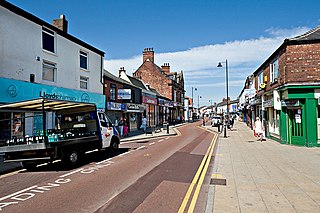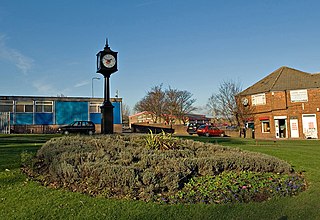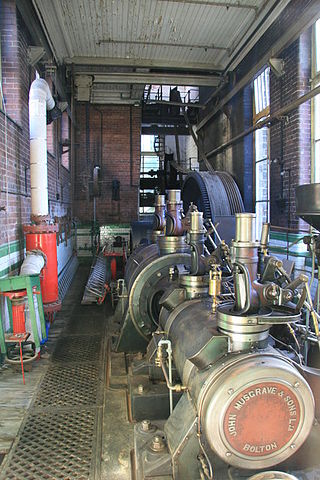
Ashton-in-Makerfield is a market town in the Metropolitan Borough of Wigan, Greater Manchester, England, 4 miles (6.4 km) south of Wigan. In 2011, it had a population of 28,762.

Westhoughton is a town and civil parish in the Metropolitan Borough of Bolton, Greater Manchester, England, 4 miles (6 km) southwest of Bolton, 5 miles (8 km) east of Wigan and 13 miles (21 km) northwest of Manchester.

Hindley is a town within the Metropolitan Borough of Wigan in Greater Manchester, England. It is three miles (4.8 km) east of Wigan and covers an area of 2,580 acres (1,044 ha). Within the boundaries of the historic county of Lancashire, Hindley borders the towns and villages of Ince-in-Makerfield, Aspull, Westhoughton, Atherton and Westleigh in the former borough of Leigh. In 2001, Hindley had a population of 23,457, increasing to 28,000 at the 2011 Census. It forms part of the wider Greater Manchester Urban Area.

Atherton is a town in the Metropolitan Borough of Wigan in Greater Manchester, England and historically part of Lancashire. The town, including Hindsford, Howe Bridge and Hag Fold, is 5 miles (8.0 km) south of Bolton, 7 miles (11.3 km) east of Wigan, and 10 miles (16.1 km) northwest of Manchester. From the 17th century, for about 300 years, Atherton was known as Chowbent, which was frequently shortened to Bent, the town's old nickname. During the Industrial Revolution, the town was a key part of the Manchester Coalfield.

Pendlebury is a town in the City of Salford, Greater Manchester, England. The population at the 2011 Census was 13,069. It lies 4 miles (6.4 km) north-west of Manchester city centre, 3 miles (4.8 km) north-west of Salford and 6 miles (9.7 km) south-east of Bolton.

Aspull is a village in the Metropolitan Borough of Wigan, in Greater Manchester, England. Historically in Lancashire, Aspull, along with Haigh, is surrounded by greenbelt and agricultural land, separated from Westhoughton, on its southeast side, by a brook running through Borsdane Wood. The ground rises from south to north, reaching 400 feet (122 m), and has views towards Winter Hill and the West Pennine Moors. It has a population of 4,977.

Astley is a village in the Metropolitan Borough of Wigan, Greater Manchester, England. Within the boundaries of the historic county of Lancashire, it is crossed by the Bridgewater Canal and the A580 East Lancashire Road. Continuous with Tyldesley, it is equidistant from Wigan and Manchester, both 8.3 miles (13.4 km) away. Astley Mosley Common ward had a population of 11,270 at the 2011 Census.

The Pretoria Pit disaster was a mining accident on 21 December 1910, when an underground explosion occurred at the Hulton Colliery Bank Pit No. 3, known as the Pretoria Pit, in Over Hulton, Westhoughton, then in the historic county of Lancashire, in North West England. A total of 344 men and boys lost their lives.

Golborne is a town in the Metropolitan Borough of Wigan, in Greater Manchester, England. It lies 5 miles (8.0 km) south-southeast of Wigan, 6 miles (9.7 km) northeast of Warrington and 14 miles (22.5 km) to the west of the city of Manchester. Along with the nearby village of Lowton, it had a population of 24,041.

Ladyshore Colliery, originally named Back o' th Barn, was situated on the Irwell Valley fault on the Manchester Coalfield in Little Lever, then in the historic county of Lancashire, England. Founded by Thomas Fletcher Senior, the colliery opened in the 1830s and mined several types of coal. It became infamous as a result of the owners' stand against the use of safety lamps in the mines. Women and children worked in the mines, under poor conditions.

John Musgrave & Sons was a company that manufactured stationary steam engines. It was founded in 1839 by John Musgrave and his son, Joseph, at the Globe Ironworks, in Bolton, historically in Lancashire, England.

The Lancashire Coalfield in North West England was an important British coalfield. Its coal seams were formed from the vegetation of tropical swampy forests in the Carboniferous period over 300 million years ago.
Tyldesley Coal Company was a coal mining company formed in 1870 in Tyldesley, on the Manchester Coalfield in the historic county of Lancashire, England that had its origins in Yew Tree Colliery, the location for a mining disaster that killed 25 men and boys in 1858.
The Wigan Coal and Iron Company was formed when collieries on the Lancashire Coalfield owned by John Lancaster were acquired by Lord Lindsay, the Earl of Crawford and Balcarres, owner of the Haigh Colliery in 1865. The company owned collieries in Haigh, Aspull, Standish, Westhoughton, Blackrod, Westleigh and St Helens and large furnaces and iron-works near Wigan and the Manton Colliery in Nottinghamshire.
The Hulton Colliery Company was a coal mining company operating on the Lancashire Coalfield from the mid 19th century in Over Hulton and Westhoughton, then in the historic county of Lancashire, England. The company had its origins in small coal mines on the northern part of the Hulton Park estate in 1571 owned by the Hultons who had held the estate from medieval times.

The Maypole Colliery disaster was a mining accident on 18 August 1908, when an underground explosion occurred at the Maypole Colliery, in Abram, near Wigan, then in the historic county of Lancashire, in North West England. The final death toll was 76.
Westhoughton is a civil parish in the Metropolitan Borough of Bolton, Greater Manchester, England. It includes the town of Westhoughton and the settlements of Wingates, White Horse, Four Gates, Chequerbent, Hunger Hill, Snydale, Hart Common, Marsh Brook, Daisy Hill and Dobb Brow. The area contains ten listed buildings that are recorded in the National Heritage List for England. Of these, one is listed at Grade II*, the middle of the three grades, and the others are at Grade II, the lowest grade. The listed buildings include churches and items in churchyards, memorials, a dovecote, a public house, a school, and houses later used as offices.
John Hargreaves JP was an English carrier, railway entrepreneur and manufacturing businessman. John and his father, also called John Hargreaves, were carriers in the north west of England at the time when railways were being built and taking business away from the canals.
John Hargreaves was an English carrier and businessman. Hargreaves and his son, also John Hargreaves, were carriers in the north west of England at the time when railways were being built and taking business away from the canals.













